A feast fit for a Queen
Emmanuel Cruse and the Château d’Issan team were this month (17th May 2022) joined by 70 leading figures from the UK’s fine wine trade for an evening of celebration at historic Royal landmark, Kensington Palace. Organised by WLPR, the event commemorated the 870th wedding anniversary of Eleanor of Aquitaine and King Henry II of England on 18th May 1152, whose nuptials were celebrated with the wine of Château d’Issan.
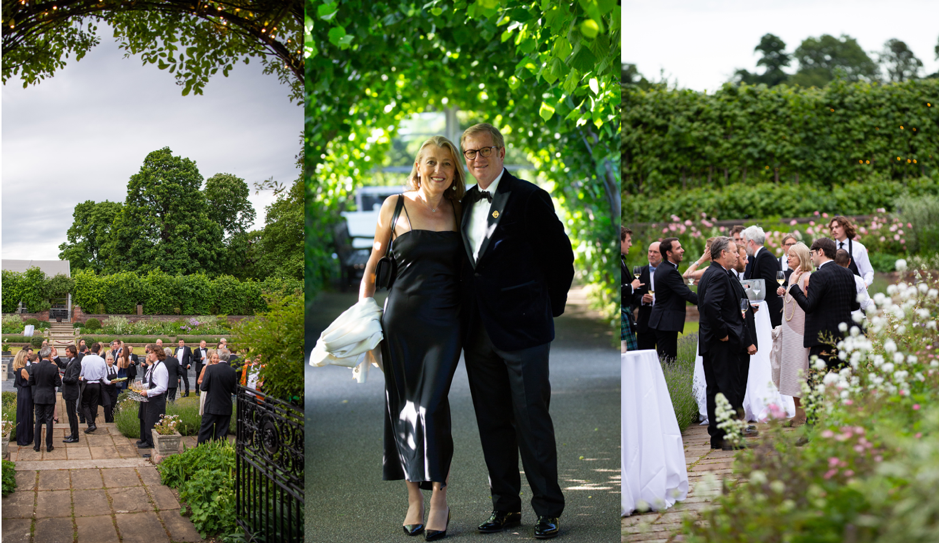 Reception in the Sunken Garden: Entering the garden (left), Virginie and Emmanuel Cruse (middle), guests enjoying 2014 Bollinger La Grande Année (right)
Reception in the Sunken Garden: Entering the garden (left), Virginie and Emmanuel Cruse (middle), guests enjoying 2014 Bollinger La Grande Année (right)
This was the third and largest of Château d’Issan’s series of banquets to celebrate the union, following an event at the Houses of Parliament in 2018 and Westminster Abbey in 2015. Emmanuel, his wife, Virginie, and Château d’Issan’s Commercial Director, Augustin Lacaille were delighted to return to London to host friends and associates in a market close to their hearts.
The reception took place in Kensington Palace’s newly-redesigned Sunken Garden (unveiled to the public for the first time in July 2021), where guests were served the 2014 vintage of Bollinger La Grande Année – a champagne to which Queen Elizabeth awarded a Royal Warrant in 1955. Following the call to dinner, guests joined a short private tour of the Palace’s State Apartments, with bespoke tour booklets leading them through its majestic halls. The banquet took place in the King’s Gallery, with Emmanuel situated below a wind-dial, which, hailing from 1694, still shows the direction of the wind to this day. Adorned on the face of the dial is Great Britain, enlarged to match up to its trusty neighbour, France.
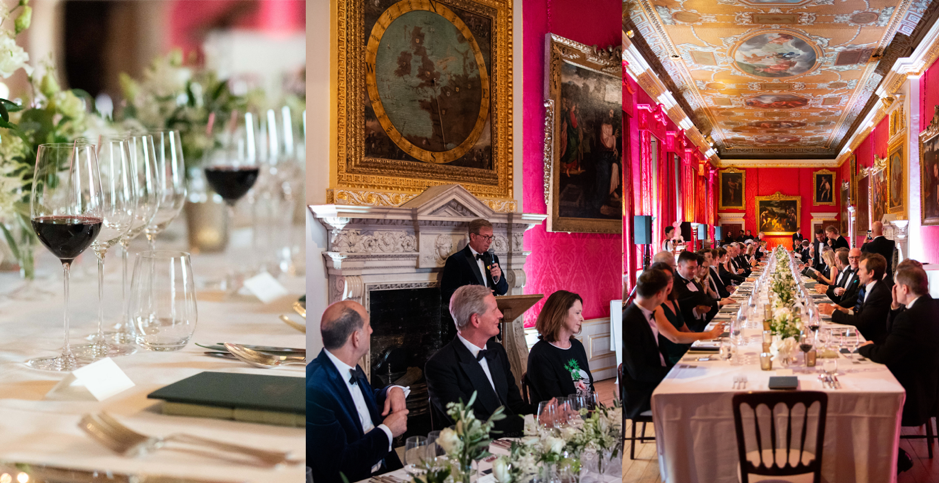 The Royal Banquet: The King’s Gallery table set (left), Emmanuel’s speech (middle), guests seated (right)
The Royal Banquet: The King’s Gallery table set (left), Emmanuel’s speech (middle), guests seated (right)
What is the connection between Eleanor of Aquitaine and Château d’Issan?
In his introductory speech, Emmanuel shared with his esteemed guests the role of Château d’Issan, formerly Lamothe-Cantenac, in consummating the marriage between Eleanor of Aquitaine and King Henry II – the former being an avid lover of Bordeaux wines. Bordeaux specialist, Jane Anson shared further historical insight into Eleanor of Aquitaine, explaining that “her contribution to England extended beyond her lifetime”, and “she continued to support the wine of Bordeaux” throughout her reign.
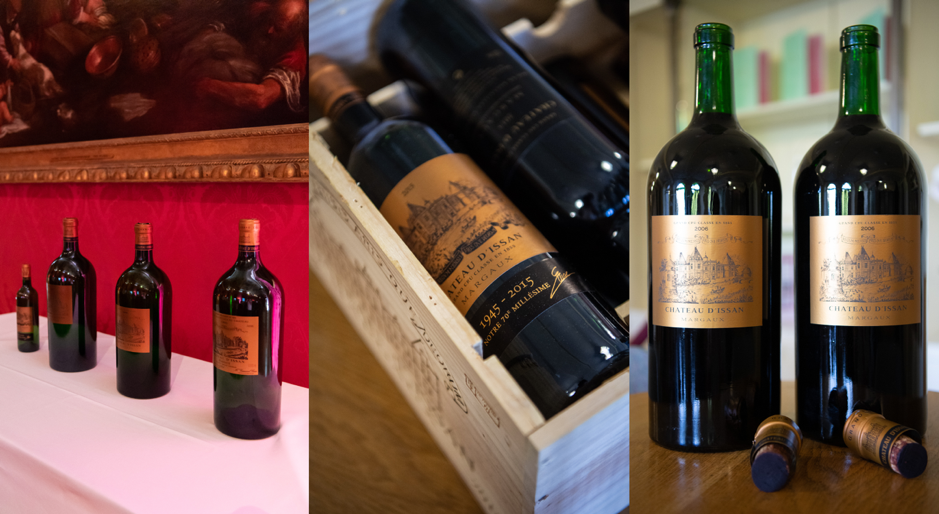 The wines: all formats displayed (left), Château d’Issan 2015 (middle), Château d’Issan 2006 in jeroboam (right)
The wines: all formats displayed (left), Château d’Issan 2015 (middle), Château d’Issan 2006 in jeroboam (right)
A bespoke menu booklet at each place setting documented Château d’Issan’s rich history, while the white flowers and green foliage adorning the centre of the table took inspiration from the flora and fauna found at the estate – as well as traditional wedding flowers.
Honing in on their union, themes of Bordeaux and Great Britain were integrated into the dinner menu: to start, guests were served Château d’Issan 2015 with a pigeon and bacon ballotine, foie gras ganache, and pear. Jeroboams of Château d’Issan 2010 were served alongside a baked cannon of lamb, confit shoulder, and potato crown. Château d’Issan 2006 was also served in jeroboam format alongside a Franco-British cheese course, comprising Comté, Mimolette, and Stilton. Finally, imperials of Château d’Issan 1995 were poured with a dessert of dark chocolate mousse, coconut sorbet, peanut, and lime.
For further information on WLPR’s tastings and events, please contact the team here.
The first Bordeaux 2021 en primeur releases have started to trickle through over the past two weeks, with key entries from Batailley, Carruades de Lafite, Duhart-Milon, Pavie, Cheval Blanc, Léoville Las Cases, Angélus, and the Barton family wines.
Kicking things off on Monday 9th May, Batailley 2021 was released at £27.50 per bottle (flat on the 2020 and 2019 release prices), setting a positive pricing tone in a year where reduced quantities had prompted apprehension. Indeed, the estate’s Managing Director, Frédéric Castèja informed Wine Lister that Batailley saw no mildew in 2021, and yields are therefore at a “normal” 50 hl/ha.
Released on Thursday 12th May at £165 per bottle, Carruades de Lafite 2021 similarly presents a discount on the 2020 and 2019 release prices, while entering the market below current prices of all recent back-vintages. The wine has shown to be one of the best price performers post-release in Wine Lister’s latest Bordeaux Study, with the 2020 already witnessing a 39% price increase over the past year. Carruades’ younger cousin, Duhart-Milon 2021 was also released on Thursday at £56 per bottle.
Another encouraging price move countering the early fears of the trade, Pavie 2021 was released on Wednesday 18th May at £232 per bottle – offering a discount of 3%-13% on all physical vintages back to 2015. Cheval Blanc 2021 was released on Thursday 19th May at a slight premium on the past two years’ release prices, though still below average prices of all back-vintages on the market up until 2014. With a quality that matches recent top vintages (2019, 2018, 2016, 2015), while priced at an average 28% below them, the 2021 has already seen successes. Indeed, one top UK merchant reports having sold “even more than last year”.
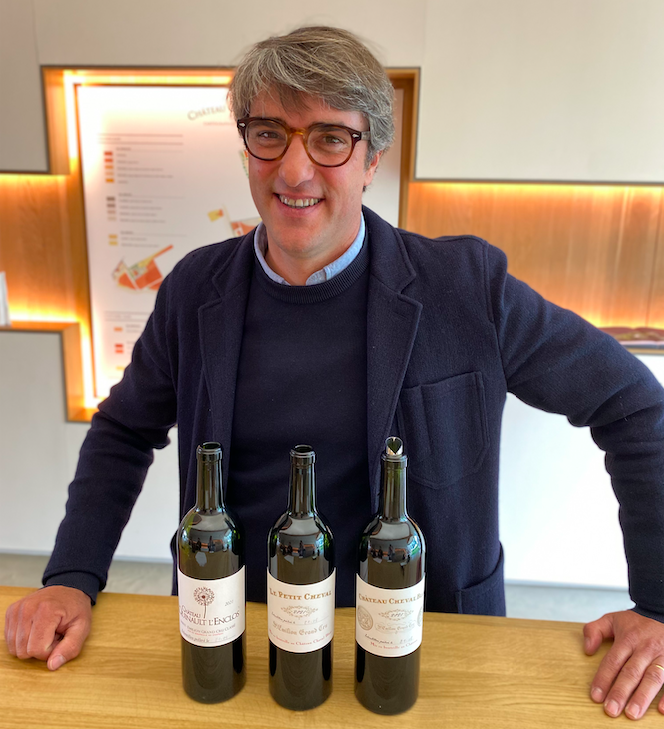
Cheval Blanc’s Technical Director, Pierre–Olivier Clouet, taking the Wine Lister team through the 2021s
A similarly successful entry (in the words of another top UK merchant), Léoville Las Cases 2021 was released on Friday 20th May at £162.50 per bottle – a significant 18% down on the 2020 release price. As well as offering the greatest discount from last year’s opening price seen of key releases thus far in the campaign, the 2021 receives a score of 94-96 from both Vinous’ Antonio Galloni and Neal Martin.
Upping the pace this week (on Monday 23rd May), we saw further releases from Angélus and the Barton family. The 2021 is the first vintage of Léoville Barton and Langoa Barton vinified in the Barton family’s new winery, and the last before the passing of the estates’ legendary owner, Anthony Barton. The vintage also marks 200 years of the family’s ownership of Langoa Barton, which will be commemorated with a special-edition label on the 2021, and the release of a limited-edition, multi-vintage case.
Also released during this period: Carillon d’Angélus, La Lagune, Petit Cheval, Cantemerle, L’Extravagant de Doisy-Daëne, Potensac.
Wine Lister’s real-time, wine-by-wine analysis of this year’s campaign is available in email newsletter form through a Pro+ subscription. For more information on this, please contact us.
Wine Lister’s COO, Chloe Ashton shares her thoughts on this year’s en primeur campaign so far.
The latest Bordeaux en primeur campaign is already underway, with Batailley 2021 opening the stage at the beginning of last week, and Domaines Baron de Rothschild’s Carruades and Duhart-Milon following suit. Cantemerle’s release on Friday 13th rounded out the week, and thus far starting prices have been a relatively pleasant surprise.
What does the trade expect from this year’s campaign?
In Part I of Wine Lister’s annual Bordeaux study, we asked key members of the global fine wine trade about their expectations ahead of the 2021 campaign. Of 47 respondents, half expected prices to be somewhat more expensive, or significantly more expensive than 2020 vintage releases, after rumblings on La Place of strong trading over the past few months.
 Bordeaux study (p.10): Founding members survey – 2021 release price expectations
Bordeaux study (p.10): Founding members survey – 2021 release price expectations
After the first physical en primeur week in Bordeaux since the 2018 vintage (our view of the vintage can be found here), the trade will at least have had the chance to work their way through a vintage so complex that tasting was surely a necessity. With such a heterogenous vintage, pricing strategies should logically also be extremely varied, making the potential successes of 2021 sales difficult to predict. Nonetheless, here’s what we know:
- Wine Lister’s annual Bordeaux study reveals that confidence in Bordeaux us up. Respondents increased ratings on last year for three quarters of the wines included in our study – after so many trade members have been reminded of the joys of tasting in situ, both these elements could contribute to campaign positivity and momentum, with merchants backing those properties they historically believe in, and/or were indeed impressed by during en primeur tastings
- 2021 appears to be a vintage that speaks from the soil, so imparting knowledge of the best terroirs to customers should help to create demand for the best-performing wines in general
- Outside of focusing only on the very best, 2021 may be a vintage for pleasant surprises – the fresher, lower-alcohol, and more classical style of wines certainly garner appeal from traditional palates, so any merchant or collector seeking this style of drinking experience in the near to mid future could do well in seeking out some of the better-value wines hailing from this complicated campaign
Wine Lister’s wine-by-wine analysis of this year’s campaign is available in email newsletter form through a Pro+ subscription. For more information on this, please contact us.
A tour of the town with our Pessac-Léognan friends
The Larrivet Haut-Brion team joined Wine Lister to catch up with industry friends and meet some new faces in London’s fine wine scene after two years of restricted travel. Alongside a wine and cheese consumer tasting and a trade lunch, a series of individual merchant meetings provided the chance for the team to reunite with a market close to their hearts.
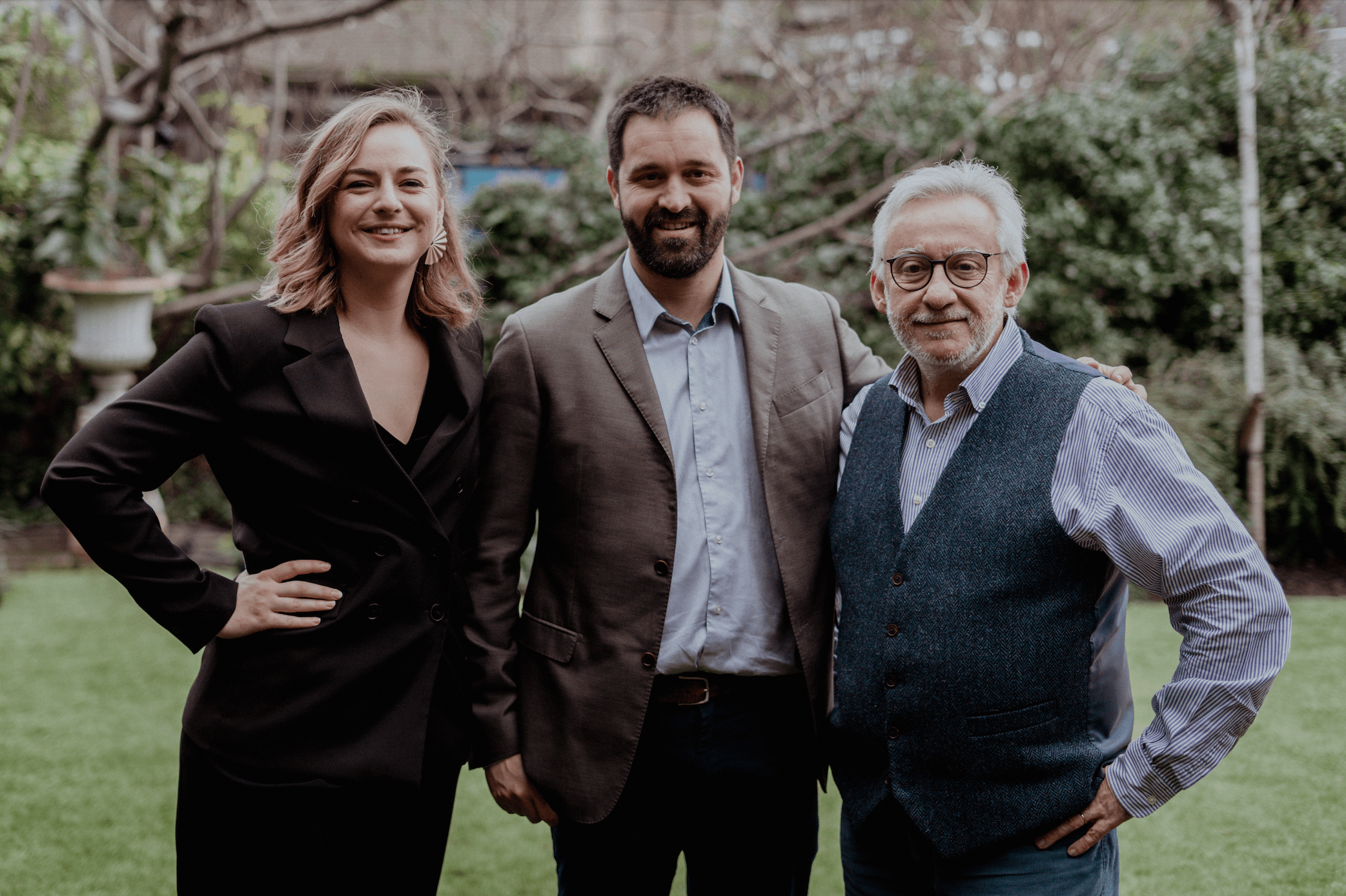 Larrivet Haut-Brion in London: (from left) Brand Ambassador Clara Bouineau, Technical Director François Godichon, Managing Director Bruno Lemoine
Larrivet Haut-Brion in London: (from left) Brand Ambassador Clara Bouineau, Technical Director François Godichon, Managing Director Bruno Lemoine
What are the latest developments at Larrivet Haut-Brion?
The viticultural evolution at Larrivet Haut-Brion kick-started with the arrival of their Managing Director, Bruno Lemoine in 2007. Fascinated by the mosaic soil structure unique to the property (with top-soils composed in patterns of graves, colluviums, or sand and clay-limestone), Bruno conducted extensive terroir analysis which informed a detailed replanting programme, allowing the team to better match grape varieties to soil types for optimum quality. Among other changes, this led to an increased proportion of Cabernet Sauvignon and Cabernet Franc vines planted across the vineyard sites.
Further changes were implemented in 2015 with the arrival of Technical Director, François Godichon, who integrated several new production methods informed by his Burgundian roots. His parcel-led approach was reinforced in 2018 with the construction of a new cellar with space and facilities for a more precise vinification of individual micro-plots.
The final piece in Larrivet Haut-Brion’s winemaking puzzle, Cellar Master, Charlotte Mignon joined the team in 2020 and drives continuous experimentations with different ageing vessels, including combinations of concrete eggs, terracotta amphorae, and both new and old oak barrels. With Charlotte unavailable to join the visit (having just welcomed her second child), the London trio was completed by the property’s Brand Ambassador, Clara Bouineau, who joined the team in January 2022.
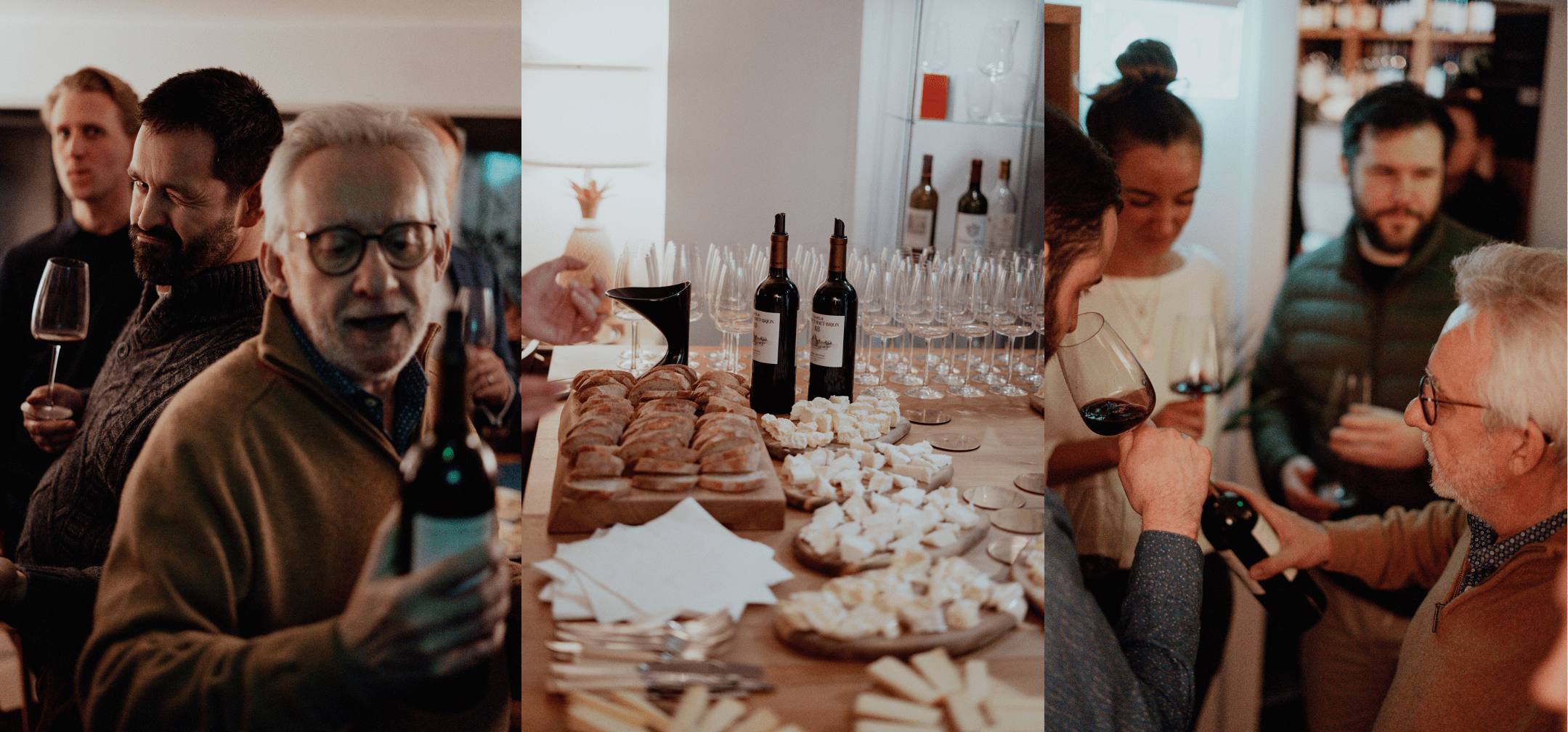 Wine and cheese tasting: Bruno and François tell guests about their wine (left), wine and cheese at Must & Lees (middle), Bruno pouring wine for guests (right)
Wine and cheese tasting: Bruno and François tell guests about their wine (left), wine and cheese at Must & Lees (middle), Bruno pouring wine for guests (right)
A marriage of Bordeaux wine with British cheese
The first stop on Larrivet Haut-Brion’s London tour was specialist wine shop Must & Lees, where the team was joined by some of North London’s Bordeaux enthusiasts for a wine and cheese evening on Wednesday 23rd February. Celebrating the estate’s commitment to the UK market, Wine Lister and Larrivet Haut-Brion devised a tasting format that showcased their red and white wines alongside a selection of 100% British cheeses from Neal’s Yard Dairy. While providing the opportunity for the team to build relationships with its consumers, the evening showcased the suitability of Larrivet Haut-Brion wines with some of the UK’s favourite fromages, including the likes of St Jude and Colston Bassett Stilton.
Wine and cheese pairing: Larrivet Haut-Brion Blanc 2017 with Sinodun Hill, Les Demoiselles Blanc 2019 with St Jude, Larrivet Haut-Brion Blanc 2014 with Baron Bigod, Larrivet Haut-Brion Blanc 2007 with Durrus, Les Demoiselles Rouge 2019 with Ogleshield, Larrivet Haut-Brion Rouge 2017 with Colston Bassett Stilton
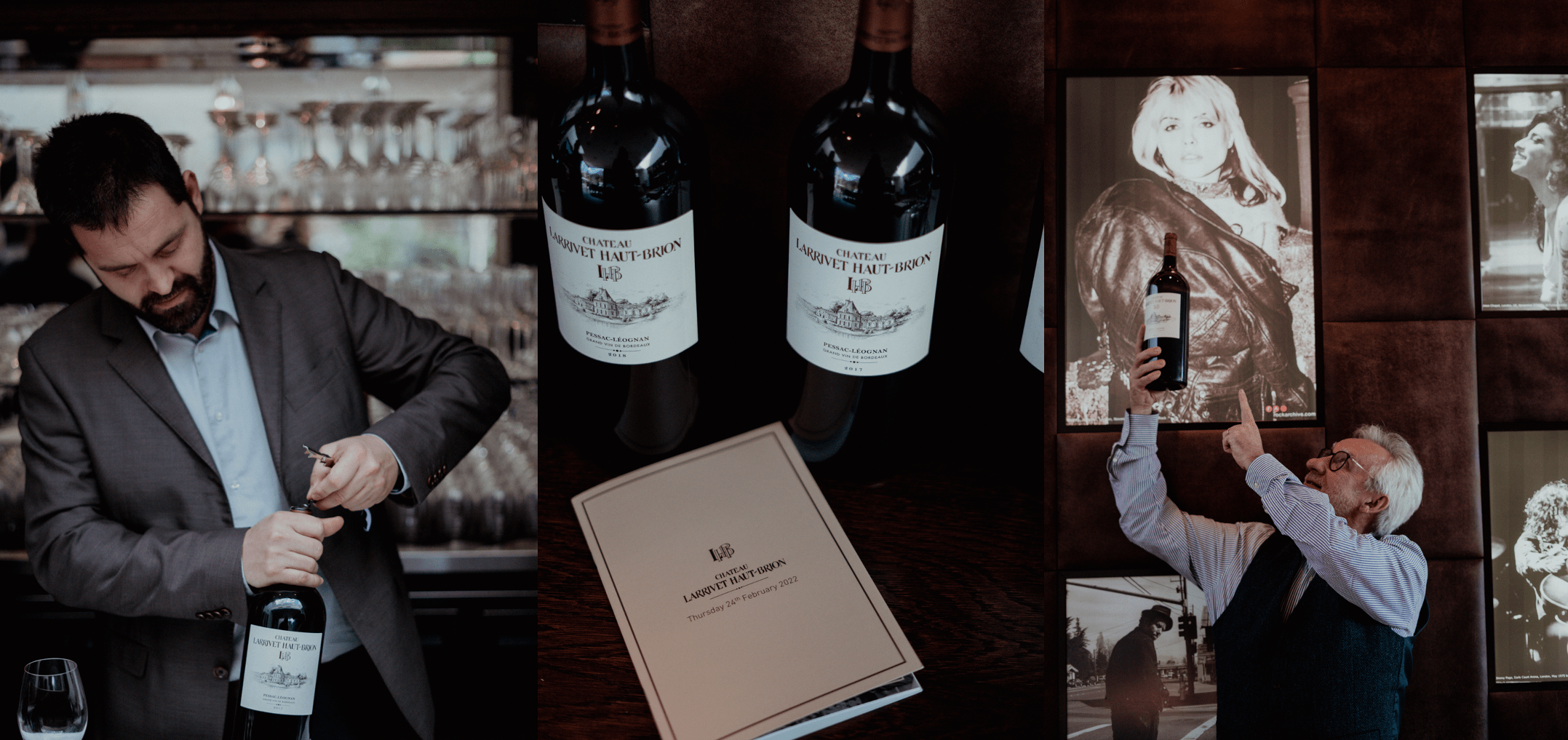 Frederick’s trade lunch: François opening a 2015 magnum (left), magnums on display with bespoke booklet (middle), Bruno presenting a magnum (right)
Frederick’s trade lunch: François opening a 2015 magnum (left), magnums on display with bespoke booklet (middle), Bruno presenting a magnum (right)
A taste for technical developments
Having already met with some of London’s key fine wine merchants, on Thursday 24th February, Wine Lister invited a handful of its fine wine trade and press friends for lunch at Frederick’s to discover some of Larrivet Haut-Brion’s best recent vintages in magnum.
With positive feedback across the board, Larrivet Haut-Brion’s whites showed freshness and complexity, thanks to the blending of Sauvignon Blanc with Sémillon from old vines grown on limestone soils. Alongside an impressive showing of some iconic recent vintages of reds (including 2005, 2010, 2015), the 2017 Rouge provided a promising picture of the future of Larrivet Haut-Brion 2021, with a low proportion of Merlot offset by a higher percentage of Cabernet Franc mirroring the projected blend of this year’s release – which may contain no Merlot at all.
To round off the lunch, the Larrivet Haut-Brion team poured some of their favourite wines from outside the property – an exercise that they believe is crucial to learn and gain inspiration from others. Amongst their “beyond Bordeaux” selection were Pierre Gerbais’ Prestige Extra Brut, Mas Jullien 2018, and Domaine Moingeon Saint-Aubin 1er Cru Sur Gamay 2018 – each giving guests a glimpse into the team’s personal preferences.
Wines tasted: Les Demoiselles Rouge 2019, Larrivet Haut-Brion Rouge 2019, Larrivet Haut-Brion Rouge 2018, Larrivet Haut-Brion Rouge 2017, Larrivet Haut-Brion Rouge 2016, Larrivet Haut-Brion Rouge 2015, Larrivet Haut-Brion Rouge 2010, Larrivet Haut-Brion Rouge 2005, Les Demoiselles Blanc 2020, Larrivet Haut-Brion Blanc 2020, Larrivet Haut-Brion Blanc 2019, Larrivet Haut-Brion Blanc 2018, Larrivet Haut-Brion Blanc 2011
For further information on WLPR’s tastings and events, please contact the team here.
As Wine Lister enters its fifth year in business, we are excited to announce the addition of 650 new wines onto Wine Lister’s information hub. Thanks to scores from our trusted partner critics, prices through our official pricing partner, Wine Owners, and data measuring popularity, as determined by the number of searches on Wine-Searcher (Pro and Pro+ site only), website users can now discover Wine Lister scores, prices, and apply decision-making analysis tools to a broader range of fine wines. With the latest additions, our database now extends across 4,450 wines, and over 40,000 wine-vintages, providing further insight to inform wine investment choices and strategic solutions.
Below we examine the regional split of the additional wines, and take a closer look at some of the properties featured in the expansion.
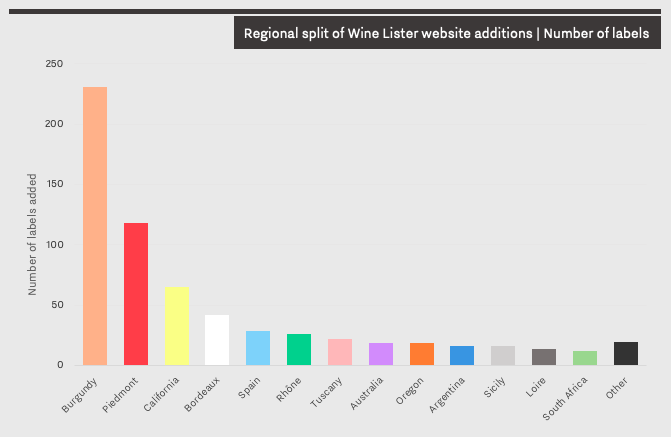
Burgundy represents 36% of the new selection, with more cuvées added from the likes of Pierre-Yves Colin-Morey, Cécile Tremblay, Benjamin Leroux, and more. A further 42 wines (6%) are added to the already-established set of Bordeaux properties featured on the Wine Lister site, including Cru Bourgeois Exceptionnels, Cambon La Pelouse, and Malescasse. Domaine des Roches Neuves represents seven out of the 10 new additions from the Rhône, alongside Bernard Baudry and Domaine du Closel.
Wine Lister’s Italian listings grow by 24% in the latest update, including 118 additions from Piedmont, 22 from Tuscany, and 16 from Sicily. The new Piedmontese picks include Arnaldo Rivera Barolo, Elvio Cogno, Figli Luigi Oddero, Giuseppe Mascarello e Figlio, and more. A region on the rise, Sicilian additions include new wines from organic Etna producers, Tenuta delle Terre Nere and Passopisciaro.
Wine Lister has also expanded its New World portfolio, which now features more additions from California (10% of the latest haul), Australia, and Oregon, among other regions. Featured amongst the new Californian picks are rising estates such as Littorai, Quintessa, Bevan, and Cardinale. Moving up the West Coast, Oregon additions include five new wines from Evening Land, four new bottles from Bergstrom, and three new picks from Antica Terra.
For more industry insights and advice on which wines and regions to buy, sign up for Wine Lister’s free newsletter here. Members of the trade can sign up to the Pro account to search and filter wines by Wine Lister Pro metrics.
Any of the producers recently added to the Wine Lister website can provide us with additional information on their wines, including production volumes, grape varieties, and label images. Email us at: team@wine-lister.com.
As the fine wine industry starts preparing for another Bordeaux en primeur season at a distance, Wine Lister has published Part I of its annual in-depth Bordeaux Study. With insights from key fine wine trade players from across the globe, Part I evaluates Bordeaux’s recent performance, considers the major takeaways from the 2019 vintage campaign, and contemplates the lessons they might provide moving forwards.
Please see our key findings below:
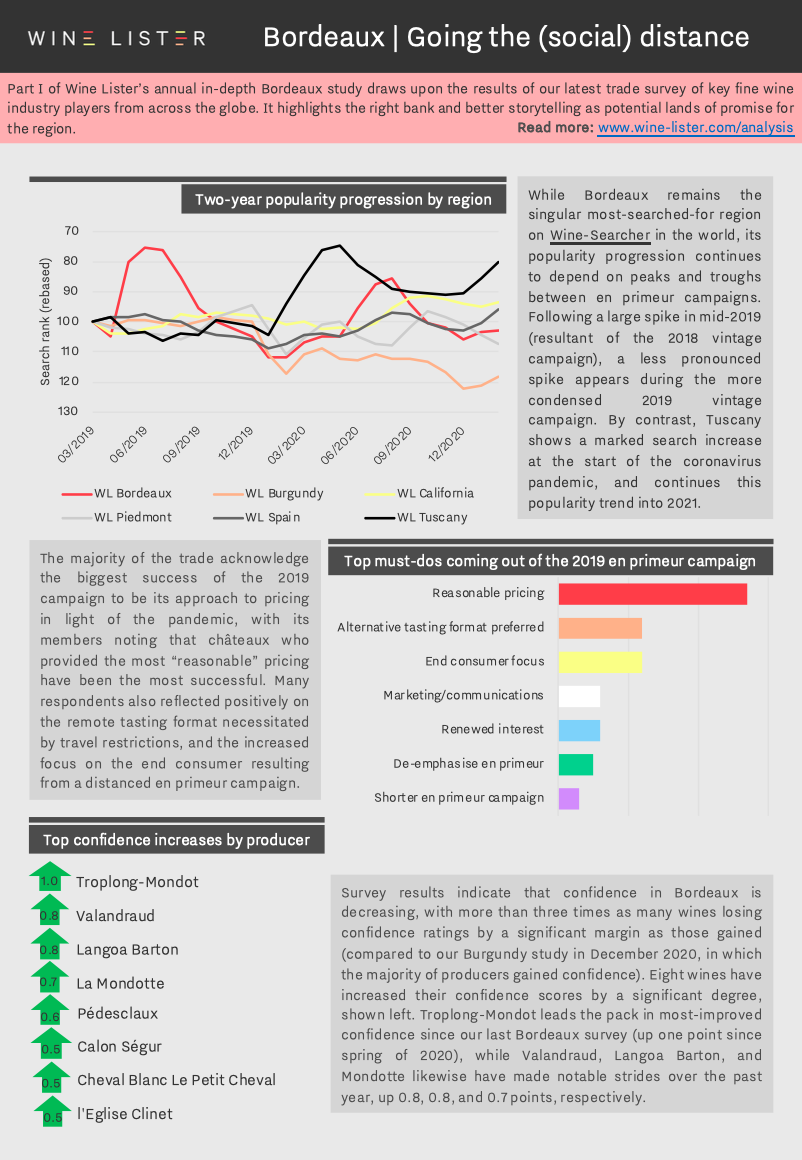
You can download the study digest in English here: Wine Lister 2021 Bordeaux Study – Digest or French here: Wine Lister 2021 Bordeaux Résumé d’étude. The full report can be purchased on our Analysis page, while Pro subscribers can access their free copy here.
With Bordeaux 2020 en primeur fast approaching, Wine Lister reports on one of the latest updates to emerge from the Médoc, informing your investment decisions over the coming months. In collaboration with Château Lafon-Rochet, we speak to Basile Tesseron to find out more about the inaugural partnership of two of the most revered consultants in Bordeaux to work on the estate’s 2020 blend: Jean-Claude Berrouet and Eric Boissenot.

Renowned for his expertise in Merlot production at Pomerol’s Château Petrus, Lafon-Rochet’s existing consultant, Jean-Claude Berrouet has been working at the estate alongside his son, Jeff, since 2012. Basile tells us that his team “admire the quality of the tannins present in the wines that Jean-Claude consults on, as well as his expertise with grapes coming from clay soils”.
With almost half of the estate based on clay, and the other half on dry, deep, gravely soils, he explains that “it was logical to combine Jean-Claude’s work with that of Eric Boissenot”, whose father, Jacques, has also been working with Lafon-Rochet for several years. With a reputation as oenologist to some of the Médoc’s top châteaux, Eric Boissenot is known for his dedication to the accentuation of terroir.
This meeting of minds from the Right and Left Banks for the first time illustrates another step in the evolution of Lafon-Rochet under Basile’s guidance. Since taking over the running of the estate in 2007, he has overseen the construction of two new cellars, extensive replanting, and a dedicated biodiversity programme. Having spent several years conducting agroforestry trials, last year Lafon-Rochet embarked on an agroforestry scheme that aims to make the estate wild once again through assisted natural regeneration. As well as installing bat nesting boxes and beehives, the property aims to plant 13,000 trees on its land by 2022.
Click here to sign up to Wine Lister’s free newsletter to keep track of everything en primeur over the coming months, including our recommendations on which releases to buy.
WL PR offers a dedicated communications service to help fine wine producers tell their story within the UK market. Head to our services page here to find out more.
In an industry so defined by the art of its craft, the limit of crunching numbers often starts and ends for wineries in vat rooms and through lab panels. Wine Lister was founded on a guiding principle that while wine is a mystical liquid, that lives and breathes, that can transcend facts and figures and contribute mightily to the human experience, there are also plain truths to be found in data analytics for both consumers and producers alike. It is on this basis that we have built a strong following of website users – collectors eager to follow trends of the secondary market, and professionals keeping abreast of the latest analyses – but also liked-minded producer clients, who find value in Wine Lister’s benchmarking and bespoke analytics solutions.
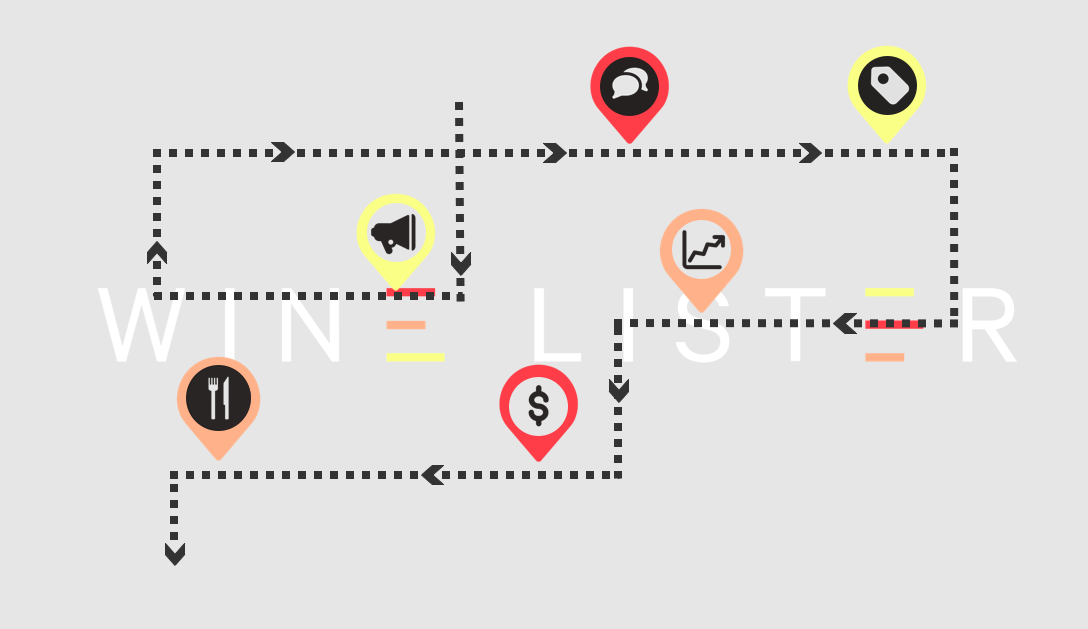
Wine Lister’s benchmarking solution relies on 14 separate data points across three areas in the life of a fine wine – Quality, Brand, and Economics – as well as qualitative trade panel feedback (through an unparalleled network from founder Ella Lister’s years as a fine wine journalist) to assess a wine’s 360° positioning in the global marketplace. Measured annually, Wine Lister’s benchmarking service enables continuous measurement of a wine within its global competitive environment, and results in a reliable, tangible reflection of progress, and ideas for the strategy path forward. Indeed, long-time Wine Lister client Don Weaver of Harlan Estate recently reflected that “It was a natural growth [to work with Wine Lister], another coming of age of our business… As we’ve matured as a business and penetrated further out into the market, we realised that we needed analytics coming back to us, and we needed best practices in our business. We can’t do everything, so we looked at Wine Lister to help us see things through different eyes.”
Such analytical rigour has resulted in numerous actionable insights for our clients, from assisting one client in increasing its journalistic coverage in a foreign market where it was underrepresented compared to peers, to a pricing strategy update for another that balanced the producer’s own interests while maintaining market confidence.
Once findings are identified, clients of Wine Lister can choose to investigate further, by supplying some of their own internal data to our analysts, enabling us to conduct deep-dives on topics as wide-ranging as customer retention, social media and communications effectiveness, or individual release price positioning. The benchmarking analysis is thus a base on which Wine Lister builds long-term relationships with its clients, helping them take their wine to the next level.
For more information, see our producer services page, or contact us for a free 30-minute consultation.
Wine Lister recently teamed up with 67 Pall Mall for a vertical tasting of five d’Issan vintages led by owner, Emmanuel Cruse, and Commercial Director, Augustin Lacaille. Last Wednesday, Emmanuel transported over 60 members of the UK fine wine trade and press to the historic Margaux property, guiding them through four of his favourite recent vintages: 2000, 2005, 2010, and 2015.
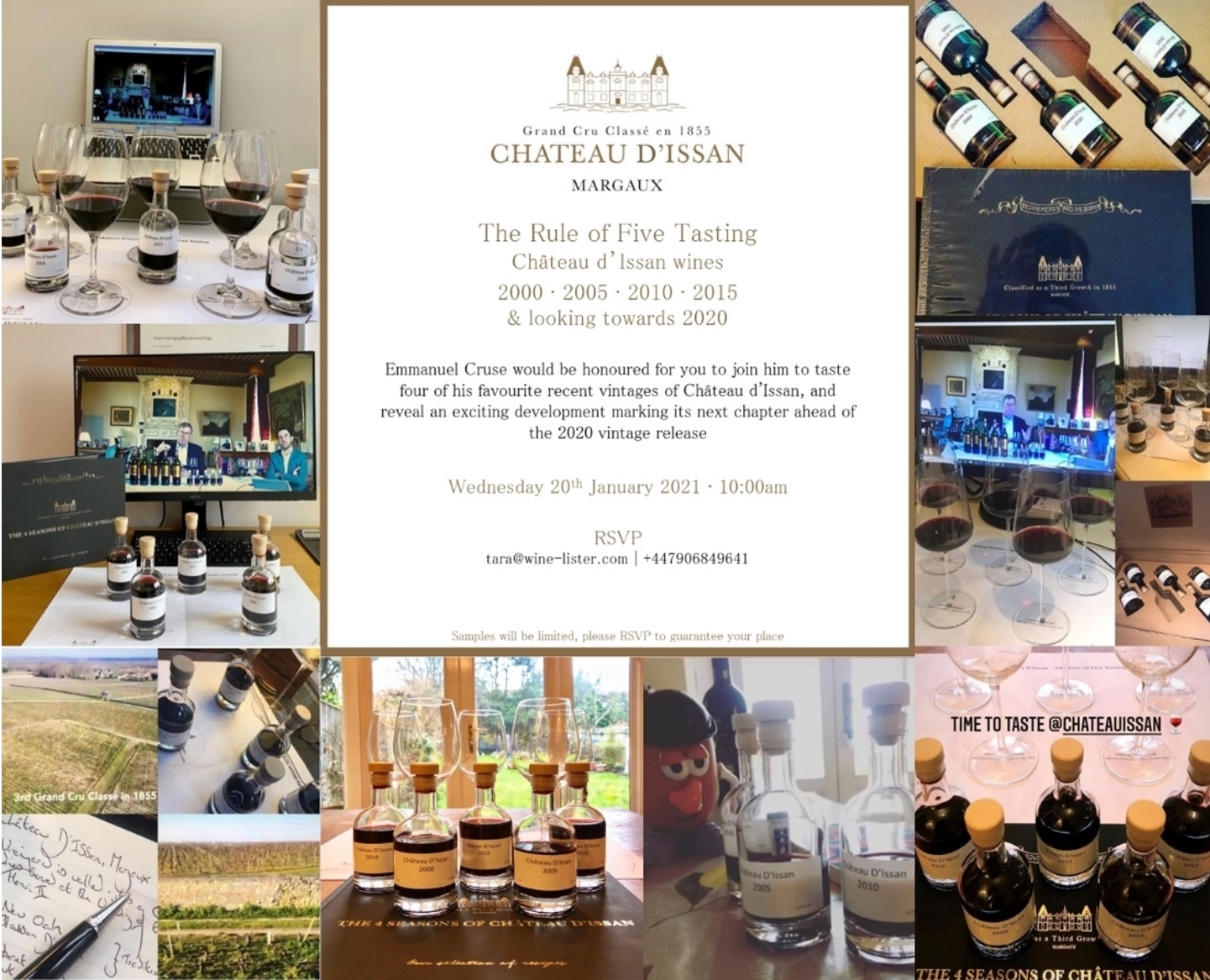 By invitation only: a selection of snaps from guests’ home tasting set-ups. Photos from (from top left anticlockwise): Bud Cuchet (@budcuchet), Charlie Goblet (@charliegoblet), Will Lyons (@mrwill_lyons), Wine Lister (@winelister), Emily O’Hare (@emilyowine), Wine Lister (@winelister), Charlie Goblet (@charliegolet), and Tom Harrow (@winechapuk)
By invitation only: a selection of snaps from guests’ home tasting set-ups. Photos from (from top left anticlockwise): Bud Cuchet (@budcuchet), Charlie Goblet (@charliegoblet), Will Lyons (@mrwill_lyons), Wine Lister (@winelister), Emily O’Hare (@emilyowine), Wine Lister (@winelister), Charlie Goblet (@charliegolet), and Tom Harrow (@winechapuk)
Tasting kits were accompanied by individual copies of The Four Seasons of Château d’Issan – a cookbook assembled by the property’s head chef, Frédéric Braud, with seasonal recipes from a year in the kitchen at d’Issan. Following a short introduction video including aerial scenes of the château and close-ups on its vines, Emmanuel commenced the vertical tasting with the 2000 vintage.
Having taken over as managing director in 1998, he proclaimed that the 2000 was the last “old school” d’Issan. Indeed, the property’s winery has since been almost entirely rebuilt, with a new cellar inaugurated in 2002. The vintage marks the last to be composed of 70% Cabernet Sauvignon and 30% Merlot, the Cabernet proportion being decreased to 60% in 2005.
Emmanuel was not shy in praising the 2005 d’Issan, calling it “the first great vintage” under his watch. He notes there was “perfect weather all year”, recounting how the summer was so warm that the pickers all worked in swimsuits, leading to abnormally regular visits from inquisitive négociants.
According to Emmanuel, 2010 is “from a technical perspective, maybe the best ever vintage made in Bordeaux”. The year had an excellent growing season, void of the hailstorms that had blighted d’Issan in 2008 and 2009. He informed us that the year was also personally special to him, marking the year he married his wife, Virginie. While still on the younger side, Emmanuel suggests decanting the 2010 for three hours ahead of its enjoyment.
The tasting concluded with the 2015 vintages of the property’s Grand Vin and its second wine, Blason d’Issan. Emmanuel stated that it was a broadly excellent year for Bordeaux, and specifically Margaux, which received “less rain than other appellations in the Medoc”. The ratios shifted slightly more towards Cabernet Sauvignon in 2015, which makes up 65% of the blend – Emmanuel’s personal preference.
Hailing from the estate’s younger vines, which are around 15-20 years old, Blason comprises 60% Cabernet Sauvignon in 2015. Emmanuel specifies the same winemaking practices are applied to the second wine, which he hopes to be “an introduction to the flagship”.
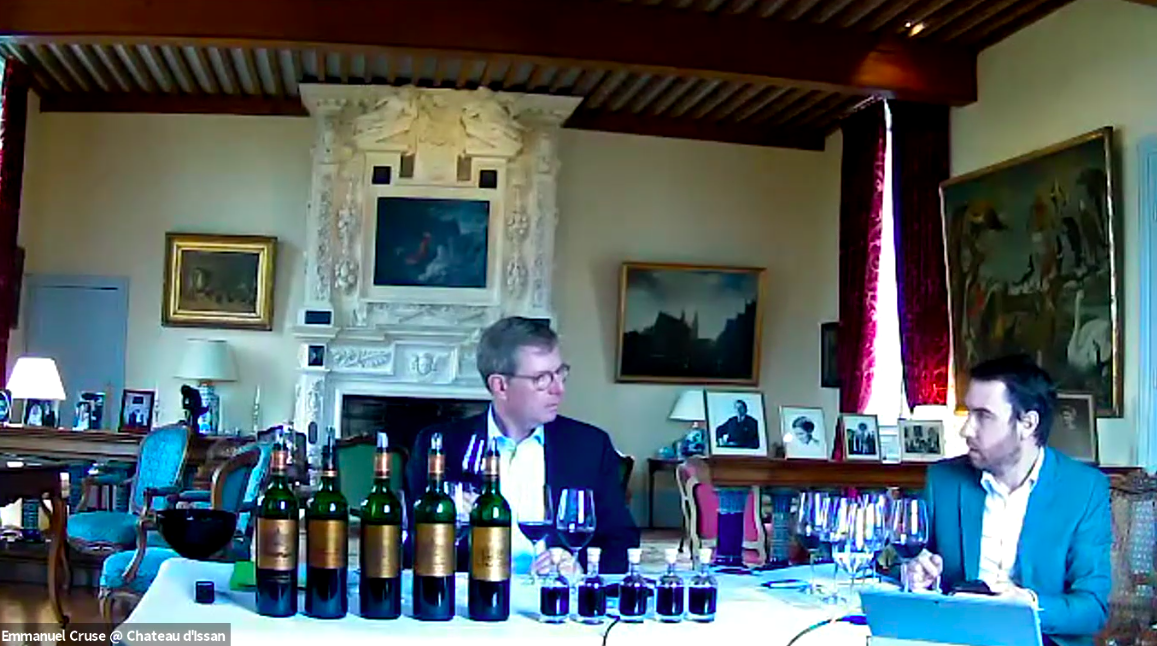 D’Issan owner, Emmanuel Cruse, and Commercial Director, Augustin Lacaille, in “The Rule of Five” virtual tasting
D’Issan owner, Emmanuel Cruse, and Commercial Director, Augustin Lacaille, in “The Rule of Five” virtual tasting
D’Issan 2020 will be released en primeur this year, and we look forward to finding out what the latest edition of “The Rule of Five” will bring – especially since the property’s acquisition of neighbouring Cabernet Franc and Petit Verdot vineyards in March 2020. While the official blend for the 2020 vintage has not been finalised, Emmanuel is sure that the added varietals will be a “real plus”. If the serendipitous pattern of five is anything to go by, especially with the excellent growing season in 2020, the “rule” has every chance of continuing to reign.
For more information on our organisation of virtual tastings and events, please contact the WL PR team here.
Wine Lister is excited to announce the arrival of its new consumer site, aimed at supporting fine wine lovers as they navigate the fine wine seas. All users now have unlimited, free access to the world’s most comprehensive fine wine data hub. Start learning how to buy wine like a pro now, or read on to find out more.
WL MUST BUYs
Wine Lister has created its own buy recommendation tool, which combines Wine Lister data with human intelligence (such as the opinion of key members of the global fine wine trade, plus insight from the Wine Lister team’s trips and tastings), to provide a dynamic list of wines any fine wine buyer should consider for their cellar. All MUST BUYs represent high quality, and value within their respective appellations and vintages.
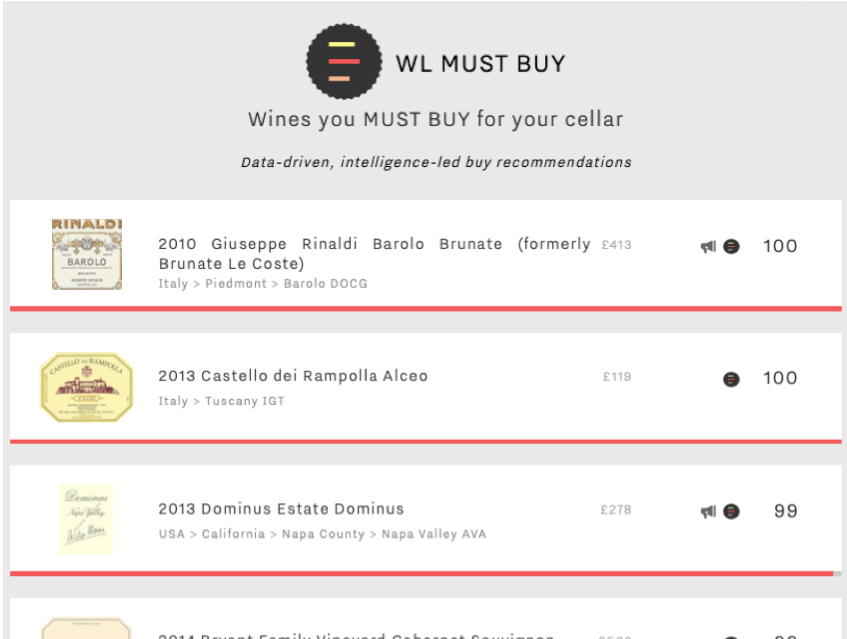 Browse the full MUST BUY list here.
Browse the full MUST BUY list here.
Aggregated, 100-point score
With a focus on quality, the new 100-point Wine Lister Score combines the ratings of five of the world’s most respected wine critics – Jancis Robinson, Antonio Galloni and Neal Martin (Vinous), Bettane+Desseauve, and Jeannie Cho Lee, together with a smaller weighting for the wine’s ageing potential. The score is as objective an indication of wine quality as possible, allowing users to make site-wide comparisons across the 30,000+ wine-vintages on Wine Lister.
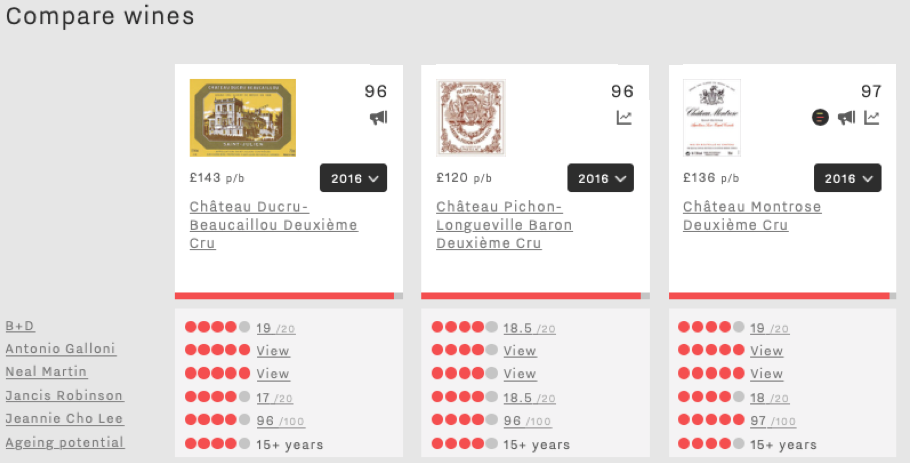
See this comparison, or create your own here.
Further analysis tools
Dynamic charts give users the chance to explore wines they might consider buying or selling in more detail.
The Vintage Value Identifier gives users a clear visual of price to quality ratios across vintages of a given wine, applying a score to this measure of relative value. See the example below for Mouton Rothschild: while the 2016 vintage is higher quality than 2014, its accompanying high price means that both the 2016 and 2014 vintages present the same level of value (the joint-highest of all recent back vintages shown)
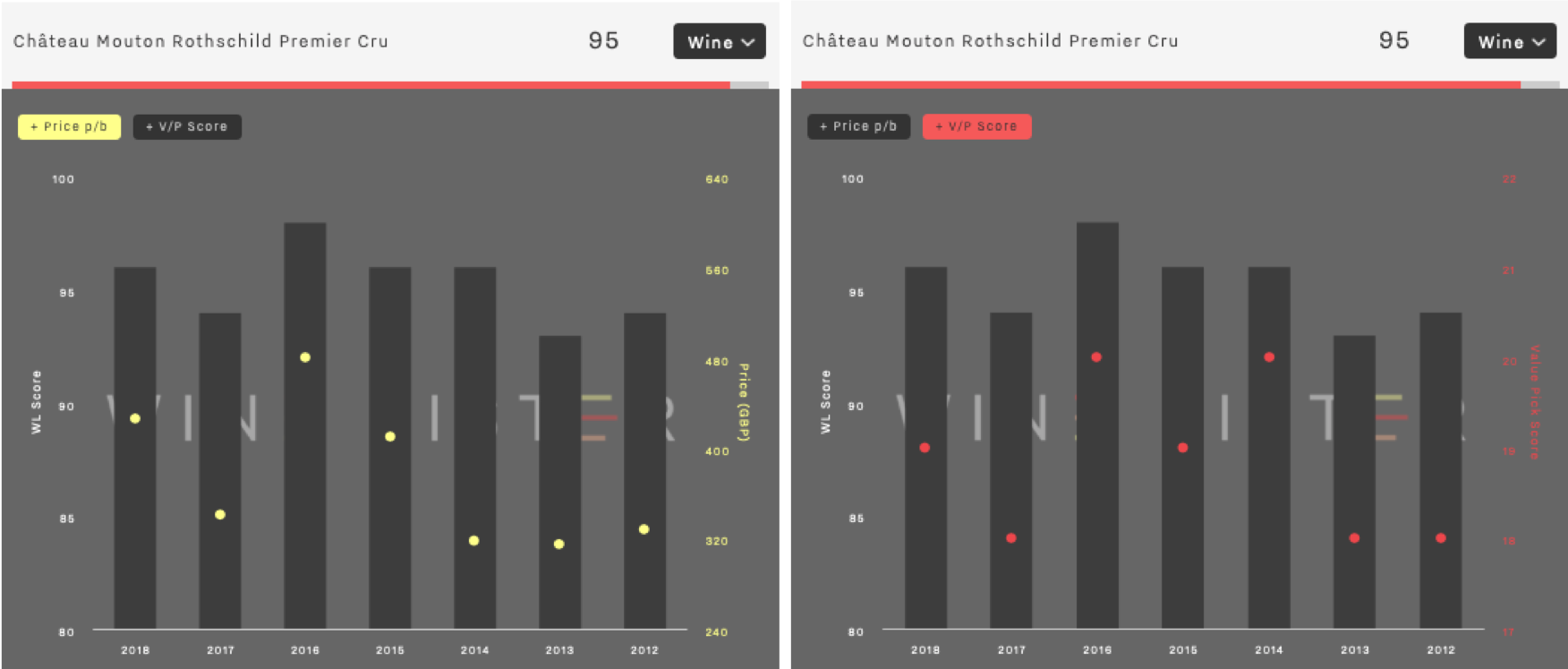 Wine Lister’s dynamic Vintage Value Identifier chart, showing price vs. quality (left) and Value Pick score (right).
Wine Lister’s dynamic Vintage Value Identifier chart, showing price vs. quality (left) and Value Pick score (right).
See the chart for Mouton Rothschild, or search for another wine here.
The Price History chart tracks a wine’s price performance over time, relative to its peer group. This can be done at vintage level, helping collectors to see performance history of a specific wine they might own. See below the example of Domaine Hubert Lignier’s Clos de La Roche 2016, whose price growth over the last year is one of the most impressive of all wines on Wine Lister (57.8%).
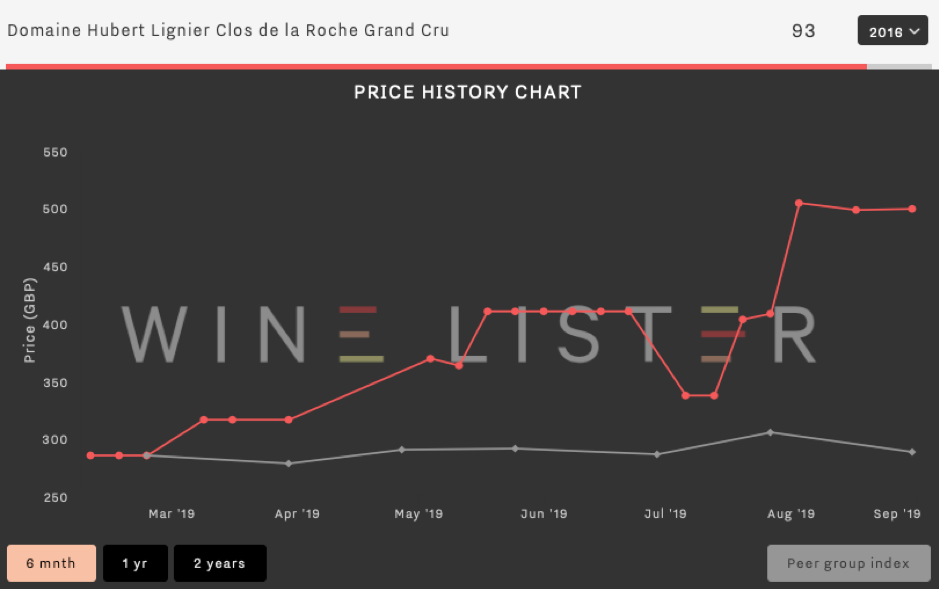 Hubert Lignier Clos de la Roche 2016’s six-month price performance compared to performance of other Clos de la Roche Grand Cru 2016s
Hubert Lignier Clos de la Roche 2016’s six-month price performance compared to performance of other Clos de la Roche Grand Cru 2016s
The same dynamic chart can be used at wine level (an average across vintages, with a stronger weighting for more recent vintages), to give a general indication of a wine’s price trajectory, and therefore whether or not the wine in question could be an investment buy. See below an example for Armand Rousseau’s Chambertin, which on average sees steady price growth, and a CAGR (compound annual growth rate) of 31.8% (though the price has flattened out this year).
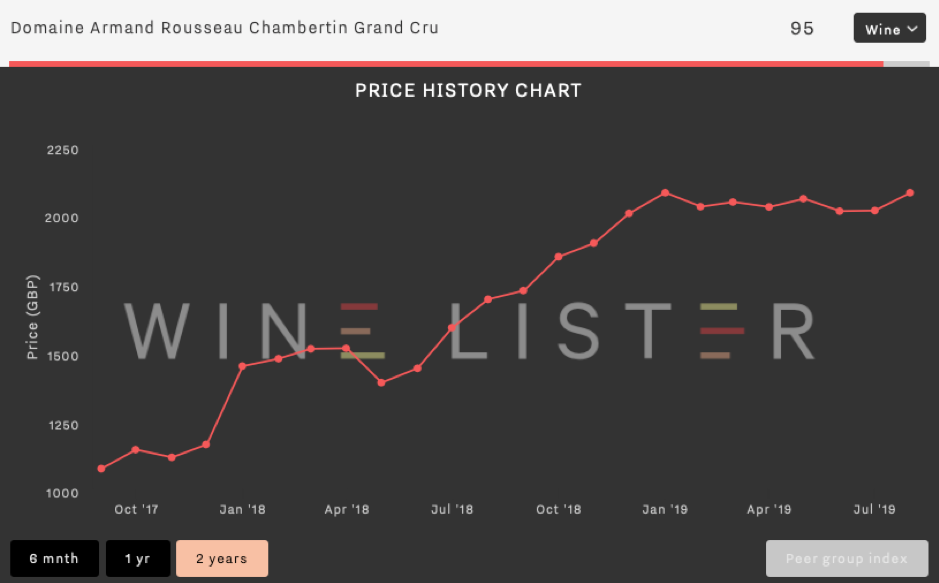 Armand Rousseau’s average price performance over two years
Armand Rousseau’s average price performance over two years
On top of these tools, each wine page gives users further information about the wine in question, including whether the wine qualifies for one of Wine Lister’s four Indicators. Haut Brion, as shown in the example below, is a Buzz Brand. See more information on other segments – Hidden Gems, Value Picks, and Investment Staples, or start browsing here.

We hope that you find the new site informative and useful for developing your fine wine collection. Feedback from our users is always welcome – please don’t hesitate to contact us with any questions or comments here.
 Reception in the Sunken Garden: Entering the garden (left), Virginie and Emmanuel Cruse (middle), guests enjoying 2014 Bollinger La Grande Année (right)
Reception in the Sunken Garden: Entering the garden (left), Virginie and Emmanuel Cruse (middle), guests enjoying 2014 Bollinger La Grande Année (right) The Royal Banquet: The King’s Gallery table set (left), Emmanuel’s speech (middle), guests seated (right)
The Royal Banquet: The King’s Gallery table set (left), Emmanuel’s speech (middle), guests seated (right) The wines: all formats displayed (left), Château d’Issan 2015 (middle), Château d’Issan 2006 in jeroboam (right)
The wines: all formats displayed (left), Château d’Issan 2015 (middle), Château d’Issan 2006 in jeroboam (right)










 Browse the full MUST BUY list
Browse the full MUST BUY list 
 Wine Lister’s dynamic Vintage Value Identifier chart, showing price vs. quality (left) and Value Pick score (right).
Wine Lister’s dynamic Vintage Value Identifier chart, showing price vs. quality (left) and Value Pick score (right). Hubert Lignier Clos de la Roche 2016’s six-month price performance compared to performance of other Clos de la Roche Grand Cru 2016s
Hubert Lignier Clos de la Roche 2016’s six-month price performance compared to performance of other Clos de la Roche Grand Cru 2016s Armand Rousseau’s average price performance over two years
Armand Rousseau’s average price performance over two years 